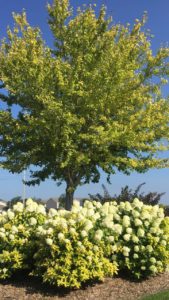 Hydrangeas are wildly popular, and with good reason-few plants are as versatile or provide such long lasting blooms. Today, we are taking a look at some of the best varieties to grow in Omaha–and how to care for them.
Hydrangeas are wildly popular, and with good reason-few plants are as versatile or provide such long lasting blooms. Today, we are taking a look at some of the best varieties to grow in Omaha–and how to care for them.
Hydrangea varieties can be divided into three general groups:
1) Herbaceous 2) Woody 3) Climbers
HERBACEOUS HYDRANGEAS die back to the ground every winter. This is the group that people often think of, when they think about hydrangeas–with the large, round, summer blooms in shades of white, pink, even blue.This type of hydrangea needs to be cut back to 12” or so in the spring or fall, to make room for new growth to emerge in the spring, from both the ground, and from buds low on the remaining canes. Every couple of years, it is beneficial to thin / remove old canes that are no longer attached to the roots. These canes can usually be snapped off by hand. Herbaceous varieties of hydrangea include:
-Hydrangea arborescens (Smooth hydrangea)–this reliable bloomer is native to the midwest and has large, round flowers which are usually white, although some red/pink varieties have become available recently. It thrives in shady, moist areas. Cultivars of this species include ‘Annabelle’, ‘Wee White’, and ‘Incrediball’, ranging in size from 2’-5’. ‘Invincibelle Ruby’ is a new cultivar with pink flowers.
-Hydrangea macrophylla (Bigleaf or French hydrangea)–this is the group that produces those infamous pink and/or blue flowers that can change color with the acidity of your soil, and includes Mophead and Lacecap varieties, including the ‘Endless Summer’ line. Though beautiful, this species is unfortunately a little more finicky than the Smooth hydrangea, and after a number of years, will often produce only a couple of blooms where once there were many, if you don’t amend the soil, and feed it all the right fertilizers, and flatter it with praise.
WOODY HYDRANGEAS are shrubs that do not die back to the ground in the winter. They range in size from 2’-8’, and produce huge conical blooms from June-frost, in various shades of pink, white and green. The shrub holds on to the dried flowers through the winter, providing a lovely textural interest during the cold season. Woody hydrangeas do not need to be cut back at all, but can be trimmed to maintain size or shape. See below for guidelines on when to trim your woody hydrangea (it depends on which species you are dealing with).
-Hydrangea paniculata (Panicle hydrangea)–very hardy, low maintenance, and tolerant of a wide range of conditions, thriving in part shade to full sun. They grow quickly and prefer moist soil, but can tolerate drought much better than the herbaceous varieties. Varieties include ‘Bobo’, ‘Little Quickfire’, ‘Strawberry Sundae’, and ‘Limelight’. Panicle hydrangeas are also available in grafted tree form.
Dense flowers set on new growth, so to avoid cutting off the flower buds before they have a chance to bloom, pruning for panicle hydrangeas should be done in the fall, winter, or early spring before the shrubs begin actively growing.
–Hydrangea quercifolia (Oakleaf hydrangea) have large, oak-shaped leaves that turn a beautiful deep red/burgundy in the fall. The branches of the shrub have attractive, exfoliating bark, which adds to the winter interest provided by woody hydrangeas. Both the branching pattern and the flower of the oakleaf hydrangea are typically more open than on the panicle hydrangea. These shrubs are fairly slow growing, and prefer moist, slightly acidic conditions and part sun to full shade. Varieties include ‘Ruby Slippers’ and ‘Alice’.
Oakleaf hydrangeas set their flowers on old wood (so this year’s flower buds developed last year), which means any pruning should be done immediately after the shrub is done flowering, to avoid cutting off next year’s blooms.
CLIMBING HYDRANGEA (Hydrangea petiolaris) is a large woody vine with white blooms in late spring-early summer. They do best in soil that is rich and moist (but not soggy), and do well in part sun to full shade. As one of the few flowering vines that can thrive in full shade, climbing hydrangeas can be a valuable addition to the shade garden.
They are slow to establish, but after a few years, the vines will take off, vigorously climbing whatever support you have provided them. The vines attach to their support structure with aerial roots AND by twining around it, so they do not need to be trained up a trellis. They DO need a fairly substantial support, as the vines become quite heavy. Climbing hydrangeas can also grow up a wall, a post, or–if no support is provided, they can even be grown as a ground cover for a large area








